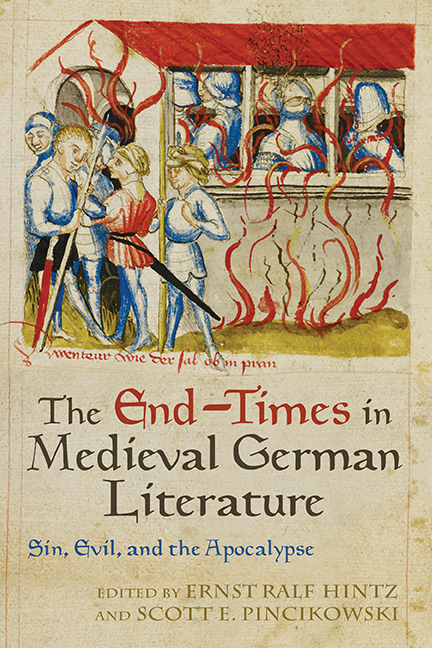Book contents
- Frontmatter
- Dedication
- Contents
- Acknowledgments
- Introduction
- 1 Thiu wirsa giburd: Cain’s Legacy, Original Sin, and the End of the World in the Old Saxon Genesis
- 2 The Heliand Revisited: Spiritual Transgendering and the Defiance of Evil
- 3 The Beginning of the End: Binary Dynamics and Initiative in Hartmann von Aue’s Gregorius
- 4 Poetic Reflections in Medieval German Literature on Tragic Conflicts, Massive Death, and Armageddon
- 5 Beyond Good and Evil: Apocalyptic Vision without Judgment in the Nibelungenlied. An Essay
- 6 End-Times in the Hall: The Modern Reception of the Apocalyptic Ending of the Nibelungenlied
- 7 Past Present, Future Present? Visualizing Arthurian Romance and the Beholder’s Share in a World That Refuses to End
- 8 Ich diene und wirbe / biz ich gar verdirbe: Lovesickness, Apocalypse, and the End-Times in Mauritius von Craûn and Das Nibelungenlied
- 9 The Slippery Concept of Evil in Hartmann von Aue’s Erec and Iwein
- 10 Wigamur’s Lessons on the Complexity of Evil
- 11 The Miracles of the Antichrist
- 12 Monsters and Monstrosities in the Pamphlet Wars of the Reformation
- Notes on the Contributors
- Index
10 - Wigamur’s Lessons on the Complexity of Evil
Published online by Cambridge University Press: 21 March 2020
- Frontmatter
- Dedication
- Contents
- Acknowledgments
- Introduction
- 1 Thiu wirsa giburd: Cain’s Legacy, Original Sin, and the End of the World in the Old Saxon Genesis
- 2 The Heliand Revisited: Spiritual Transgendering and the Defiance of Evil
- 3 The Beginning of the End: Binary Dynamics and Initiative in Hartmann von Aue’s Gregorius
- 4 Poetic Reflections in Medieval German Literature on Tragic Conflicts, Massive Death, and Armageddon
- 5 Beyond Good and Evil: Apocalyptic Vision without Judgment in the Nibelungenlied. An Essay
- 6 End-Times in the Hall: The Modern Reception of the Apocalyptic Ending of the Nibelungenlied
- 7 Past Present, Future Present? Visualizing Arthurian Romance and the Beholder’s Share in a World That Refuses to End
- 8 Ich diene und wirbe / biz ich gar verdirbe: Lovesickness, Apocalypse, and the End-Times in Mauritius von Craûn and Das Nibelungenlied
- 9 The Slippery Concept of Evil in Hartmann von Aue’s Erec and Iwein
- 10 Wigamur’s Lessons on the Complexity of Evil
- 11 The Miracles of the Antichrist
- 12 Monsters and Monstrosities in the Pamphlet Wars of the Reformation
- Notes on the Contributors
- Index
Summary
LIKE THE OTHER Middle High German thirteenth-century Arthurian romances that followed the hugely influential Erec and Iwein by Hartmann von Aue and Parzival by Wolfram von Eschenbach, the anonymously authored Wigamur long remained an object of little scholarly interest. In Wigamur's case, such inattention certainly owed much to the rather convoluted way the text comes down to us. The only complete, and very late, manuscript—MS W (Cod. Guelf. 51.2. Aug. 4°) from the last three decades of the fifteenth century, maintained by the Herzog August Bibliothek in Wolfenbüttel—is characterized by language that is far removed from the norms of classical Middle High German, that is laden with errors, and that often resists easy understanding. Additionally, there exist in the main manuscript a large number of inconsistencies in the storyline as well missing pages, gaps that the two fragments, MS S and MS M, only partially fill in and that might date from the earliest periods of the text's transmission. When we consider also that for Wigamur, whose main manuscript was first edited as early as 1808 by Johann Gustav Büsching, neither a truly user-friendly edition nor a translation into a modern language existed until the last decade, then it is not difficult to understand why the romance has remained underappreciated.
As with so many other so-called postclassical works that earlier scholars derided as unimaginatively derivative of first-generation Arthurian romances, there is, however, much that is innovative in the way that Wigamur is constructed. Among several rather original traits, for instance, and one that has not received sufficient attention from scholars, is the distinctive, rich complexity of the romance's characters.4 Unlike typical characters from across the genre, who conventionally are almost entirely good or entirely bad, positive characters in Wigamur often display bad qualities and do bad things, and, conversely, negative characters frequently possess positive qualities, do worthy deeds, and emerge as sympathetic.5 It is the purpose of this essay to look at three characters from that latter category of negative figures in Wigamur— namely, the wild woman Lespia, the robber-knight Lord of Pontrafort, and King Lipondrigun of Gurgalet—and to show how the actions of these multisided, complex figures contribute to a unique message on the nature of evil: that evil, too, is complex, that it exists in gradations, and that those who perpetrate evil often have multiple motives for doing so.
- Type
- Chapter
- Information
- The End-Times in Medieval German LiteratureSin, Evil, and the Apocalypse, pp. 216 - 237Publisher: Boydell & BrewerPrint publication year: 2019



